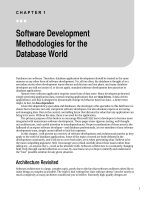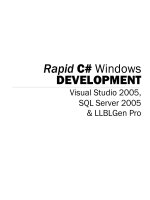Rapid software development
Bạn đang xem bản rút gọn của tài liệu. Xem và tải ngay bản đầy đủ của tài liệu tại đây (133.09 KB, 15 trang )
©Ian Sommerville 2004 Software Engineering, 7th edition. Chapter 17 Slide 1
Rapid software development
©Ian Sommerville 2004 Software Engineering, 7th edition. Chapter 17 Slide 2
Objectives
To explain how an iterative, incremental
development process leads to faster delivery
of more useful software
To discuss the essence of agile development
methods
To explain the principles and practices of
extreme programming
To explain the roles of prototyping in the
software process
©Ian Sommerville 2004 Software Engineering, 7th edition. Chapter 17 Slide 3
Topics covered
Agile methods
Extreme programming
Rapid application development
Software prototyping
©Ian Sommerville 2004 Software Engineering, 7th edition. Chapter 17 Slide 4
Rapid software development
Because of rapidly changing business
environments, businesses have to respond
to new opportunities and competition.
This requires software and rapid
development and delivery is not often the
most critical requirement for software
systems.
Businesses may be willing to accept lower
quality software if rapid delivery of essential
functionality is possible.
©Ian Sommerville 2004 Software Engineering, 7th edition. Chapter 17 Slide 5
Requirements
Because of the changing environment, it is
often impossible to arrive at a stable,
consistent set of system requirements.
Therefore a waterfall model of development
is impractical and an approach to
development based on iterative specification
and delivery is the only way to deliver
software quickly.
©Ian Sommerville 2004 Software Engineering, 7th edition. Chapter 17 Slide 6
Characteristics of RAD processes
The processes of specification, design and
implementation are concurrent. There is no detailed
specification and design documentation is
minimised.
The system is developed in a series of increments.
End users evaluate each increment and make
proposals for later increments.
System user interfaces are usually developed using
an interactive development system.
©Ian Sommerville 2004 Software Engineering, 7th edition. Chapter 17 Slide 7
An iterative development process
Validate
increment
Build system
increment
Specify system
increment
Design system
architectur e
Define system
deliverables
System
complete?
Integ rate
increment
Valida te
system
Deliver final
system
YES
NO
©Ian Sommerville 2004 Software Engineering, 7th edition. Chapter 17 Slide 8
Advantages of incremental development
Accelerated delivery of customer services.
Each increment delivers the highest priority
functionality to the customer.
User engagement with the system. Users
have to be involved in the development
which means the system is more likely to
meet their requirements and the users are
more committed to the system.
©Ian Sommerville 2004 Software Engineering, 7th edition. Chapter 17 Slide 9
Problems with incremental development
Management problems
• Progress can be hard to judge and problems hard to find
because there is no documentation to demonstrate what
has been done.
Contractual problems
• The normal contract may include a specification; without a
specification, different forms of contract have to be used.
Validation problems
• Without a specification, what is the system being tested
against?
Maintenance problems
• Continual change tends to corrupt software structure
making it more expensive to change and evolve to meet
new requirements.
©Ian Sommerville 2004 Software Engineering, 7th edition. Chapter 17 Slide 10
Prototyping
For some large systems, incremental
iterative development and delivery may be
impractical; this is especially true when
multiple teams are working on different sites.
Prototyping, where an experimental system
is developed as a basis for formulating the
requirements may be used. This system is
thrown away when the system specification
has been agreed.
©Ian Sommerville 2004 Software Engineering, 7th edition. Chapter 17 Slide 11
Incremental development and prototyping
Incremental
development
Thro w-a way
prototyping
Delivered system
Executa ble pr ototype +
Systemspecifica tion
Outline
requir ements
©Ian Sommerville 2004 Software Engineering, 7th edition. Chapter 17 Slide 12
Conflicting objectives
The objective of incremental development is
to deliver a working system to end-users.
The development starts with those
requirements which are best understood.
The objective of throw-away prototyping is to
validate or derive the system requirements.
The prototyping process starts with those
requirements which are poorly understood.
©Ian Sommerville 2004 Software Engineering, 7th edition. Chapter 17 Slide 13
Agile methods
Dissatisfaction with the overheads involved in design
methods led to the creation of agile methods. These
methods:
• Focus on the code rather than the design;
• Are based on an iterative approach to software
development;
• Are intended to deliver working software quickly and
evolve this quickly to meet changing requirements.
Agile methods are probably best suited to
small/medium-sized business systems or PC
products.
©Ian Sommerville 2004 Software Engineering, 7th edition. Chapter 17 Slide 14
Principles of agile methods
Principle Description
Customer involvement The customer should be closely involved throughout the
development process. Their role is provide and prioritise new
system requirements and to evaluate the iterations of the system.
Incremental delivery The software is developed in increments with the customer
specifying the requirements to be included in each increment.
People not process The skills of the development team should be recognised and
exploited. The team should be left to develop their own ways of
working without prescriptive processes.
Embrace change Expect the system requirements to change and design the system
so that it can accommodate these changes.
Maintain simplicity Focus on simplicity in both the software being developed and in
the development process used. Wherever possible, actively work
to eliminate complexity from the system.
©Ian Sommerville 2004 Software Engineering, 7th edition. Chapter 17 Slide 15
Problems with agile methods
It can be difficult to keep the interest of customers
who are involved in the process.
Team members may be unsuited to the intense
involvement that characterises agile methods.
Prioritising changes can be difficult where there are
multiple stakeholders.
Maintaining simplicity requires extra work.
Contracts may be a problem as with other
approaches to iterative development.
©Ian Sommerville 2004 Software Engineering, 7th edition. Chapter 17 Slide 16
Extreme programming
Perhaps the best-known and most widely
used agile method.
Extreme Programming (XP) takes an
‘extreme’ approach to iterative development.
• New versions may be built several times per
day;
• Increments are delivered to customers every 2
weeks;
• All tests must be run for every build and the
build is only accepted if tests run successfully.
©Ian Sommerville 2004 Software Engineering, 7th edition. Chapter 17 Slide 17
The XP release cycle
Break down
stories to tasks
Select user
stories for this
release
Plan release
Release
software
Evaluate
system
Develop/integ rate/
test software
©Ian Sommerville 2004 Software Engineering, 7th edition. Chapter 17 Slide 18
Extreme programming practices 1
Incremental planning Requirements are recorded on Story Cards and the Stories to be
included in a release are determined by the time available and
their relative priority. The developers break these Stories into
development ŌTasksÕ.
Small Releases The minimal useful set of functionality that provides business
value is developed first. Releases of the system are frequent and
incrementally add functionality to the first release.
Simple Design Enough design is carried out to meet the current requirements
and no more.
Test first development An automated unit test framework is used to write tests for a new
piece of functionality before that functionality itself is
implemented.
Refactoring All developers are expected to refactor the code con tinuously as
soon as possible code improvements are found. This keeps the
code simple and maintainable.









